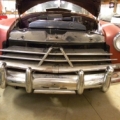Numerous eight-cylinder parts for sale
Hudsy Wudsy
Senior Contributor
Gentlemen, I have an assortment of engine parts that acquired to rebuild an '50 eight that I won't be using. I'm going to offer them for sale in the future, but first I'd like to confirm some details with those of you who know better than I. My first question is about valve guides. I have a full set of sixteen, but some of them are ones that were used on earlier (maybe up to '42?) engines. I was told that while their exterior is a somewhat different, they function the same as the later ones and are interchangeable. Could one of you confirm that? Also, I have a set of eight 0.0020" oversize connecting rods which are NORS in that they were not poured by some local shop but were the type that you got when you bought from NAPA, or a similar supply house, maybe even a Hudson dealer. The difference being that the ready-made, in stock ones were ones that the babbitt was applied through the spray-weld process and not poured. It's been some time since I read about their differences, but I recall that the ones that I refer to are a more dense bearing and have a life expectancy like the factory rods, and not the sixty to seventy thousand miles that poured rods customarily have. Can any of you confirm or deny these claims. I absolutely do not want to make unsubstantiated claims, or mislead anyone as to what they will be buying. Also, I'm not confident that "spray-weld" is the correct term, but it's what was used when I got them. I may have other questions for another time, but your help with these is greatly appreciated.
James P Sheehan
MPLS
James P Sheehan
MPLS
0
Comments
-
I wish I could help you with this but I am interested if your research becomes more complete. I have an eight in my -49 that is going to need gone through.
0 -
interested in the answer to this question, too0
-
The process was called centrifugal spraying, and was done in special machine in which the pre-heated tinned rod was inserted and the metal sprayed on to it through a spinning mandrel. Certainly far superior to the later to gravity poured metal as done by engine rebuilders, in that the metal as denser, and had no pockets or impurities.0
-
The methods of application, are one aspect. Mostly controlled buy equipment the shop has.
The metalurgy of the material is most important.
Signifficent improvements in 50's to babbit type materials as used by GM.
Hart Machine Services, see link
Babbitt Bearings – Hart's Machine Service (hartsmachineservice.com)
Hans0
Categories
- 36.9K All Categories
- 113 Hudson 1916 - 1929
- 20 Upcoming Events
- 92 Essex Super 6
- 28.6K HUDSON
- 573 "How To" - Skills, mechanical and other wise
- 995 Street Rods
- 151 American Motors
- 178 The Flathead Forum
- 49 Manuals, etc,.
- 78 Hudson 8
- 44 FORUM - Instructions and Tips on using the forum
- 2.8K CLASSIFIEDS
- 608 Vehicles
- 2.2K Parts & Pieces
- 77 Literature & Memorabilia
- Hudson 1916 - 1929 Yahoo Groups Archived Photos

